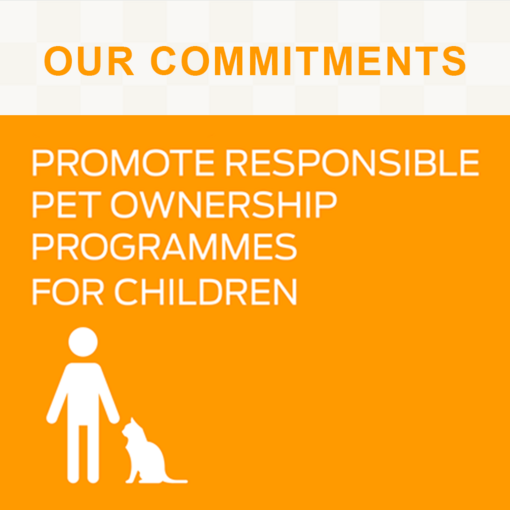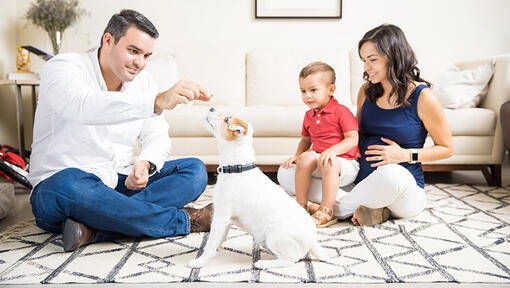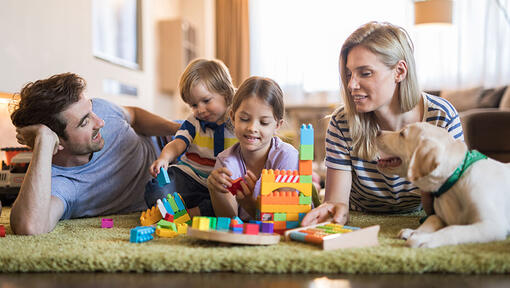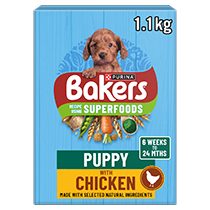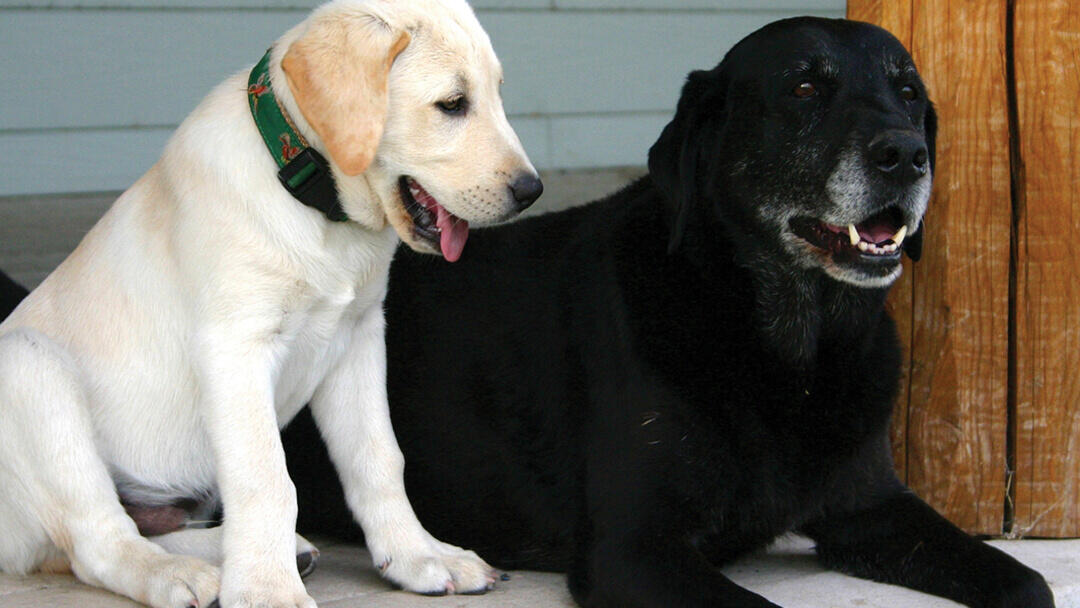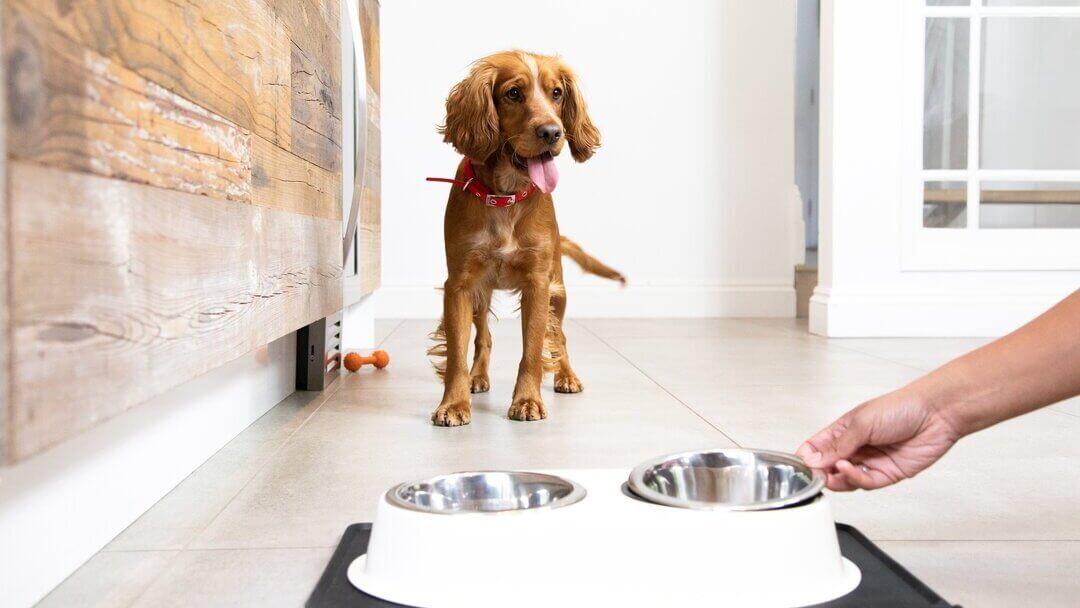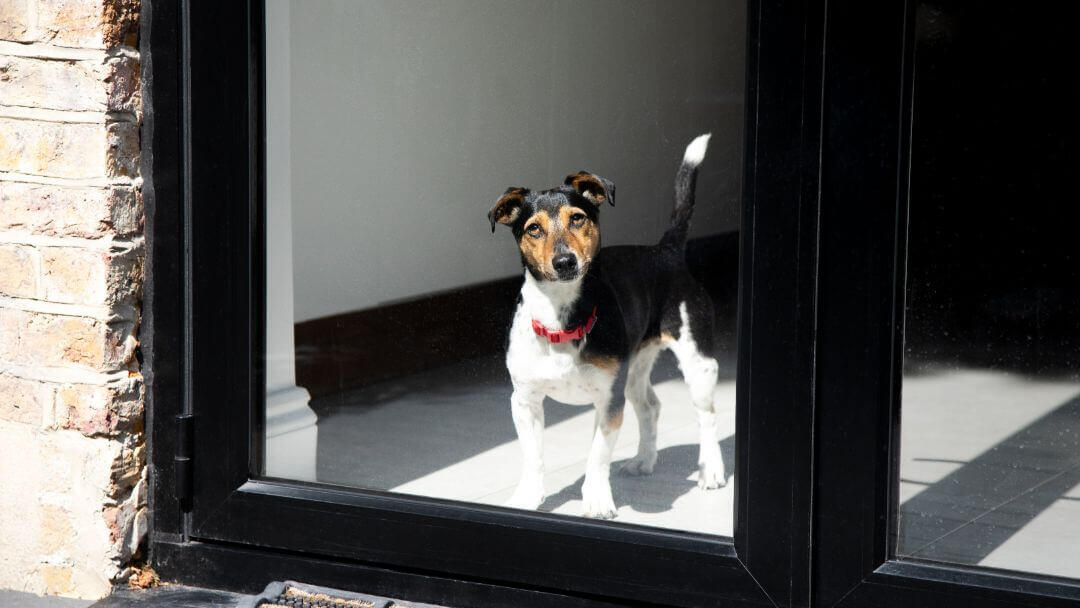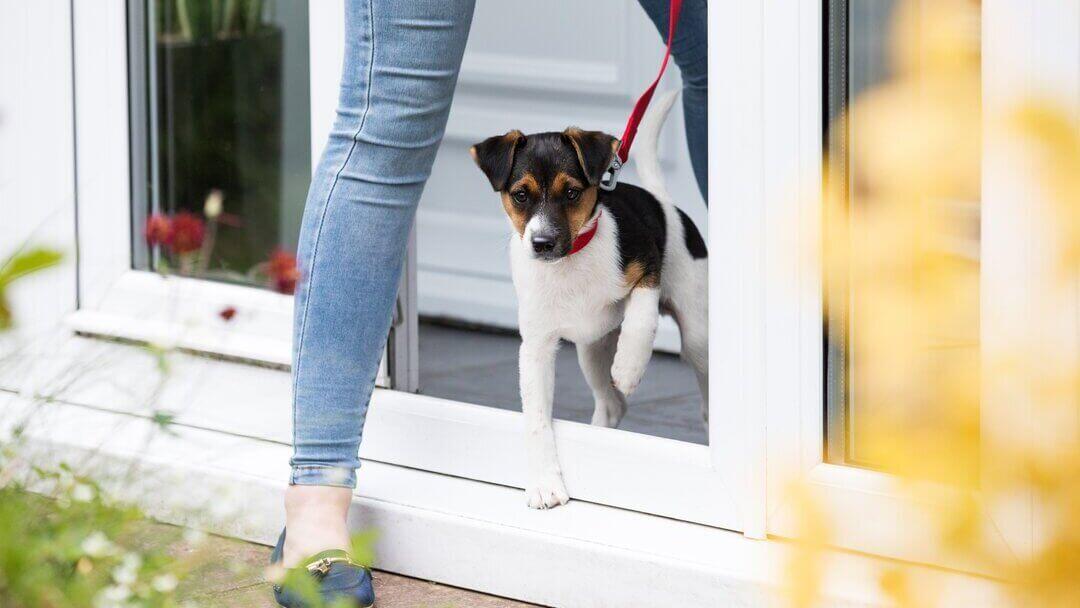

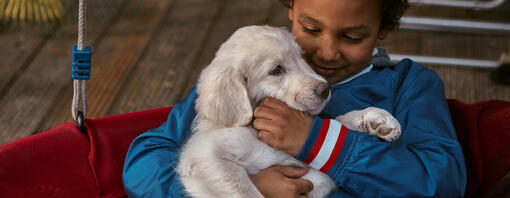
Puppies and children can have a loving relationship when introductions are done right. Find out how to get their relationship off to a flying start.
Just like our children, our dogs are part of our families. It’s only natural that we want them to get on and become lifelong friends, but getting them to that stage can be tricky. If you’ve recently got a new puppy or had a new baby, you may be wondering about dogs and children and how to begin the relationship. At Purina, we’ve put together this useful guide that tells you how to introduce a dog to a baby or child and the first steps you should take to create the building blocks for a loving, understanding friendship.
Introducing dogs and children
If you’re expecting a new puppy and have a young child, you’ll need to educate them how to approach dogs with care and respect their boundaries. Put yourself in your dog’s shoes – children are small, make sudden movements and are known to make high pitched noises, all of which are things that will intimidate and frighten a dog.
Additionally, because puppies look cute and cuddly, children will often associate them with soft toys or teddy bears and are likely to treat them as such. So if they’re not taught from the start to be gentle, they’ll probably squeeze and chase them. It’s important to try and teach your child that a dog is a living, breathing, sentient creature who can feel scared, worried or uncomfortable just like they do, and that they need to interact with them gently and quietly.
Learn dog body language
Another factor to consider is that when children are very young, they don’t have the social skills to identify when a puppy is scared or uncomfortable. They’ll also struggle to identify dog’s body language and won’t understand when they’re being aggressive or telling them to back off. It’s important that as a parent and potential dog owner, you learn how to read dog body language so you can tell when they are feeling worried or uncomfortable. By knowing this, you can prevent any misunderstandings or accidents happening either with your own dog or dogs of family and friends. Some of these signs can be quite subtle, but once you start looking out for them, you will be able to see them clearly.
Signs of an anxious dog:
- Yawning
- Licking their lips or nose
- Showing the white of their eyes
- Holding their ears back
- Looking away from the child (or whoever is touching them) or just trying to walk away
Your child, especially if quite young, is very unlikely to spot these signs so it’s important that you do. By being able to do this, and not to expect your dog to be happy being hugged, grabbed or chased, you can prevent your dog feeling overwhelmed, scared or defensive. In most cases where a child is injured or bitten, it isn’t because the parent wasn’t present, it was because the parent didn’t know what signs they were looking for.
You should explain to your child that you should never poke, squeeze or pull at your dog and only use quiet voices when around them. It’s also a good idea to tell them never to wake a sleeping pup as this may cause them to snap. If you need more information on educating your child on dog ownership, take a look at Purina Pet school, an interactive tool for teaching the pet owners of tomorrow.
Preparation
By setting some basic house rules, as a family, before your new puppy or dog arrives, you will help your children to understand what’s expected of them. Just as you will do with your puppy or dog, you’ll be teaching your children what you WOULD like them to do.
- Rather than ‘no shouting around the dog’ the rule could be ‘quiet voices only around the dog’, or, as teacher’s say; ‘indoor voices only’ around the dog!
- Rather than, ‘never poke, squeeze or pull at your dog’ the rule could be ‘gently stroke the dog, only when s/he comes to you’ so that the child beings to respect the dog’s boundaries. If they’re taught to only stroke the dog when the dog comes to them and that they stop when the dog moves away, the dog will quickly learn to trust them.
- Rather than ‘never wake a sleeping puppy’ the rule could be, ‘when the dog is asleep, it’s time for us to do…’ and then list some of your child’s favourite activities. Having a safe space for your dog to retreat to is vital and teaching your children that it’s a no-go area when your dog is asleep is also vital. However, telling your children it’s a ‘no-go area’ makes it even more enticing, so give them a fun alternative.
You can practice all of these rules before the new puppy or dog arrives so that you’re prepared. Your new friend will thank you for it.
Steps to introduce puppies and children
Whether you’re bringing a puppy or an older dog home, you will have had the opportunity to meet them and spend time with them first, whether that’s at the breeder’s home or through the rescue centre.
For a puppy - especially one who hasn't seen many small children – children don’t look like the adults they may be used to. They make sudden jerky movements, often smell strange, and frequently produce some very odd noises - all of which are things that can intimidate, frighten or excite a puppy.
For your child, the introduction of a puppy is really exciting and so it is easy for them to scare their new best friend without meaning to.
These introductions will help your new friend to learn that you’re kind and can be trusted; the basis for any successful relationship. Remember that the aim is to encourage a calm and gentle approach and to help with that, make sure that your child isn’t carrying their favourite toy or eating anything during this meeting. If possible, have two adults present, so that one can focus on the dog and one on the child. If you have multiple children, it can be less overwhelming for everyone, especially the dog, if the introductions are phased with one or two children at a time.
The best way to introduce puppies and children are as follows:
- For your first introduction, find a space in the centre of the room where the puppy doesn’t feel cornered and where they feel they can easily escape if they feel they need to.
- Get your child to calmly approach from the side, then allow your puppy to come the rest of the way. The puppy needs to be able to approach in their own time and not feel they are being forced into a scary situation.
- For the first meeting, let the puppy explore your child themselves so they get a chance to sniff them, see them, hear them - and realise they are safe and just like a human only smaller!
- Once the puppy and your child are quiet and comfortable, you can let your child offer the back of their hand with their fingers curled in for the puppy to sniff. This is unthreatening for the puppy, reduces the likelihood of your child grabbing the puppy - and also means fingers are out the way of chewing range!
- If your puppy is happy and enjoying the interaction, you can ask your child to gently stroke their head and neck, avoiding sensitive areas like the ears, tail, feet and stomach.
- If either are getting over-excited, use baby gates or a crate/play pen to separate them and repeat the introduction when they are more relaxed.
By keeping introductions gentle and low-key, and fully supervised, both the puppy and your child can begin to gain confidence with each other, and this will help get the relationship off on the right foot. If your child is old enough, encourage them to join in with dog walking, grooming and training as the puppy grows up – this helps encourage the bond between them.
Benefits of looking after a dog
There are so many benefits to dog ownership and looking after one can have lifelong advantages for your child and can teach many valuable lessons. Some of the key benefits are:
- Looking after a puppy helps children learn responsibility.
- Caring for dogs increases empathy and helps your child to understand the cycle of life.
- Having a puppy also provides plenty of opportunities for exercise and fun.
- Studies show that children who grow up with a dog have fewer days off school and are healthier
Teaching dog skills to older children
With over 12.5 million dogs in the UK alone, and with a third of households owning a dog, there is no doubt that at some point your child will come into contact with a dog they don’t know. By giving them some simple skills, you can keep them safe, help them enjoy the company of dogs throughout their life. These skills are also useful for your own dog - and once learnt, they are never forgotten.
The secret is to teach your child about consent - and that it is as important that the dog wants to be touched as much as they want to touch them! So often we touch dogs or interact with them without even considering for one second if we have their consent – or even thinking that they can give it and that we need it. Dogs have limited ways to indicate their lack of consent – and one of those can be dangerous and often hurts! And all the others break down trust.
First of all, it is important to teach children not to approach strange dogs - even if the owner says it is OK. They know not to approach strange people - as it’s not safe - and it is the same with dogs.
In social situations however - such as when you are with friends or family (and even with your own dog), finding out if you have their consent couldn’t be easier and so it is simple to teach to others.
- Have any interactions in a place where the dog feels relaxed and comfortable – and without them being contained in any way.
- Then wait until they solicit attention - not the other way round. This is a clear sign that at this point, you have consent to interact.
- Keep interactions low key and quiet. If you are stroking them, rubbing their ears, or giving them any kind of physical contact, do it with the dog unrestrained so they can escape – and only do it for 5 seconds. Then stop.
- If the dog moves away or leaves, you do not have consent to continue. If they rub against your hand for more, push up against you, or in some way solicit more contact, then you have consent to carry on. For another 5 seconds. Keep repeating – and remember that consent can be withdrawn at any time.
It really is that simple! By teaching children this one simple skill, the vast majority of dog bites will be prevented and the relationship between them will be one based on mutual trust.
How to introduce a dog to a baby
When considering how to introduce a puppy to a baby, it’s important to remember it’ll be a huge change for your dog. They are used to being the focus of your attention and may not understand why things have suddenly changed. In turn, while you are excited about the birth of your baby, it is important to remember that your dog still needs your attention too.
Preparing your dog for a new baby
As you’re getting prepared for your new arrival, you should be preparing your dog too! By following our tips you’ll make the whole experience less stressful for you both and get the eventual introductions off to a great start.
Set up stair gates
Do some work with your dog before the baby comes home. Set up baby gates in key doorways, and practice leaving your dog while you go from room to room (leave them with a treat or something to chew as a pleasurable distraction) so they begin to get used to not being able to follow you everywhere. These gates will be invaluable when the baby comes home as when you need to, you can keep your dog at the other side of a gate, but they don’t feel shut away, and can still see what is going on and see where you are. They can also get used to seeing the baby but from a safe distance.
Crates can be useful
If they are crate trained, setting up a large crate in your main room will mean your dog can relax in the crate while you are focused on the baby but will still be with you and be part of family life. Practise this too before the baby comes home so there isn’t suddenly a change in routine.
Changes to their routine
Try and get your dog used to a new routine that’s centred around caring for your baby (feeding times and sleeping times) before the birth, and give them a chance to get used to the other objects that come with a baby, such as you walking with a pushchair. Practice as much as you can before you have to do it ‘for real’ – when you will have lots of other things to think about!
Refresh their basic training
In the run-up to the birth, remind your dog of simple training exercises such as not jumping up (especially when you are carrying things) and also sitting for a reward. Both of these will be important when you are carrying your baby around the house. If you are finding this difficult, contact a trainer or behaviourist to help you before your baby comes home.
Get them used to baby sounds
Use sound effects of a baby crying so your dog gets used to the new noises.
After your baby’s born
Once your baby comes home you can help your dog get used to their new family member with our handy tips listed below:
Get them used to your baby’s smell
If you have the baby in hospital, try and let the dog smell something from you from the hospital (such as a blanket) that smells of the baby before they come home.
Make time for your pup
On the whole, try to not to treat your dog any differently (difficult though that can be) – and make sure they still get your attention and have plenty of opportunities for ‘dog time’. They still need your attention, walks, and games, and behaviour problems can arise if they are neglected, bored, frustrated or under-exercised - or just that suddenly you are not paying any attention to them.
Keep them busy
When you’re busy with your baby, keep your dog busy with enrichment toys – and play with your dog or just interact with them when your baby is asleep. Remember they still love you and need your love in return.
Get help, if you need it
If to start with you’re not able to dedicate enough time to exercise your dog, find a dog walker or enlist the help of a family member to either walk your dog or babysit your baby. A new baby is a busy and exciting time – and managed well, your baby and your dog will become the very best of friends.
The golden rule
Never leave a puppy or dog and a child alone together; regardless of how tolerant your dog is and how well your child has adapted to the house rules. You might not know if your dog is in pain and therefore has a lower tolerance to the noises they’re normally used to. Your child could accidentally fall over onto the dog and frighten them. We all have off days and for the safety of your child and your dog, their relationship needs to develop under supervision, rewarding calm and gentle interactions on both sides.
If you have any concerns about the behaviour of your dog with your children keep them separate and consult an accredited and experienced behaviourist immediately who can help you.
That’s our guide for introducing dogs or puppies and children. Looking to add a four-legged friend to your family? Read our guides on the best dog breeds for families and kids, and puppy socialisation, next.



